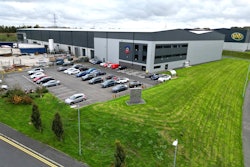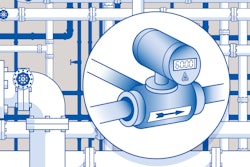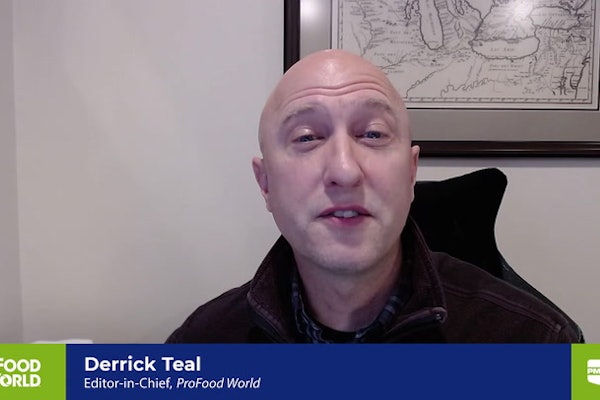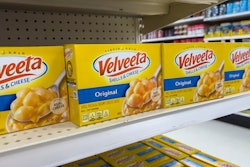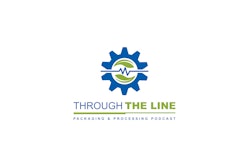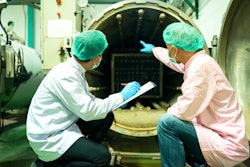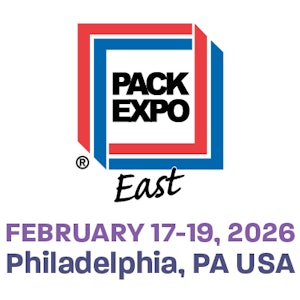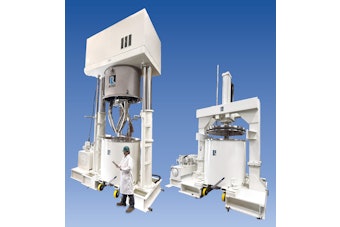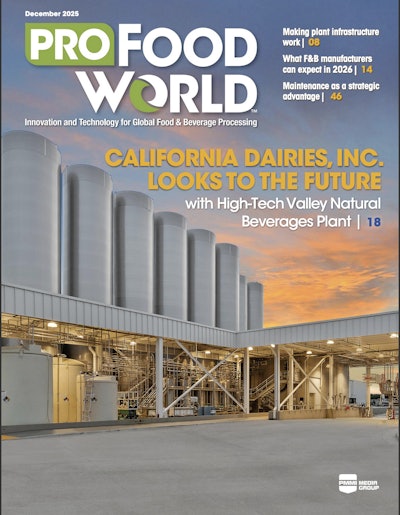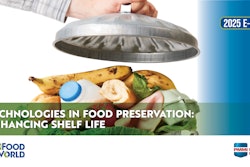Derrick Teal: Welcome to the ProFood World Video Interview Series. I'm Editor in Chief, Derrick Teal. This series explores the latest and greatest in food manufacturing by talking to industry leaders to know the ins and outs of what's important and what you need to know now in food processing operations, whether you're here for some fresh insights or just curious about what's important for your operations, you're in the right place. This episode is hosted by Bryan Griffen of Griffen Executive Solutions. Let's jump in.
Bryan Griffen: Hello everyone. I'm Bryan Griffen, host of the ProFood World Video Interview Series. Today, we're diving into total cost of ownership, how to think like a savvy investor when buying equipment for your plant. So I've spent over 30 years in food and beverage manufacturing, including global roles in electricity and automation for Nestle, the world's or one of the world's largest food producers. And I've led major capital projects, defined engineering standards, worked closely with equipment suppliers from across the world. So I've seen firsthand how focusing only on the upfront price of the machine can cost you far more in the long run. So we're going to dive into some of those details today with my guest Greg Flickinger. Greg has 25 years of experience in the CPG industry, with expertise across diverse roles, including strategic technology development, R&D, operations, supply chain, and executive leadership. Throughout his career, he's held positions such as COO and CEO, demonstrating a strong track record in operational and strategic leadership. His experience spans a wide range of organizations from large corporations like General Mills and HEB to mid-size companies such as Snyder's-Lance and GTI, as well as leadership in private equity and venture capitalist space. Currently, Greg serves as the CEO of Aloha Medicinals and American Botanicals. Greg, thanks for joining us.
Greg Flickinger: Great to be here, Bryan. Great to address total cost of ownership. And quite honestly, I can't think of a more important topic for companies, both big and small, because, as you know, companies need to get a return on every precious capital dollar they spend.
Bryan Griffen: Absolutely, absolutely. So let's, let's jump right into the shark tank. The machine looks shiny, the price is low, but then someone whispers, "maintenance costs." Boom, you're out. So what is the total cost of ownership, and why should plant managers and engineers even care?
Greg Flickinger: Yeah, great question, Bryan. And total cost of ownership. The reason that that engineers should worry plant managers and especially operations is because it's the total lifecycle cost of the piece of equipment. So think of it as from cradle to grave and all the costs in between. And so when you focus just on purchase price, that's effectively like going up to a building and looking at the sign outside and deciding to buy it. You really need to go inside of the building and look at the infrastructure and look at all the details to make sure that it actually is a good investment. So when we think about total cost of ownership, when it comes to equipment, we're looking at things like the upfront engineering design cost, of course, the purchase price. And then from that point, you're looking at factory acceptance testing, other pre tests, before the equipment ships. Then you have shipping costs, then you have the site preparation, the installation, commissioning, qualification and validation, and don't forget employee training. So you've got maintenance training for your maintenance teams, and then your operators are going to run the equipment training. And those are all the upfront costs just to be ready to run the equipment to make product. So then, then there's things that we're all familiar with. You've got your direct labor, which are your hourly employees. You've got your indirects, which are maintenance and maintenance parts, sanitation, and you can't forget about utilities. You've got compressed air, electricity, all the things to run and maintain the equipment. Then, as the equipment ages, your equipment cost for maintenance will probably begin to go up. And then you get to the end of the lifespan, where you've got to think about removal and disposition. Is it going to be sold? Is it going to be scrapped. But when you look at buying a piece of equipment, you need to think about all of these costs. For instance, if you're buying basis just sticker price, and you buy a bargain piece of equipment, which might be half the cost of a high quality piece of equipment from a reputable OEM, that might look great, but the minute you get it into a manufacturing environment where you might need to run 24/7, especially in the food and beverage industry, where it's very demanding and harsh operational conditions oftentimes, that bargain asset can require a lot of maintenance. It can be down quite frequently, and you're pouring more and more and more money into it. And then the problem becomes this, if you think about your costs after one year, that bargain equipment may actually cost more than what it would have cost to purchase and operate the high quality piece of equipment. Then you take it even further out. You look 3, 4, 5 years down the road, you probably could have bought the high quality equipment four times for the cost of running and maintaining what appeared to be a bargain piece of equipment. It really would cost you a lot more money.
Bryan Griffen: Yeah. Now we've seen that kind of a scenario when you buy a car, for instance, even. You buy a nice BMW or Mercedes, and yeah, the sticker price is high, but it's going to last a lot longer than that old Yugo, that company didn't even last very long. They can't keep the cars on the road. So, so yeah, you're certainly right. There's, there's definitely a lot that the sharks are missing when they only look at that initial purchase price.
Greg Flickinger: That's right, and Bryan TCO provides the visibility, so you get to look at the full package and really understand what you're buying before you actually make that decision. So it's about visibility.
Bryan Griffen: Yep, yep. So let's take a look then, at some of the valuation strategies that you might take into consideration when you're looking at this, this new piece of equipment. I mean, we're trying to do our due diligence. We're trying to do the best that we can. But how do we know what that total cost of ownership actually is? How do you estimate? How do you figure out what it's going to cost in maintenance, what it's going to cost in in disposal at the end of life? How much the utilities are going to run me every month just to keep this, this machine running? How do I figure all that out without just, you know, taking wild guesses from the air?
Greg Flickinger: Yeah. I guess Bryan, when I think about these types of assessments, it's important to get alignment. And to get alignment, you need a framework. And back to your point, we talked about a lot of the major buckets of TCO, but the framework is what's important. And really honestly, where I go is I go to the OpX Leadership Network's TCO Framework. So you can find it online. It's a comprehensive view of TCO, and it was created by industry experts for industry. But when you when you open that up, it has all of the buckets I just described, many, many more details. And there's even an adjoining spreadsheet. So there's a spreadsheet to help bring you along the process. So, Bryan, it all starts with the framework. So once you have the framework in place, then it comes down to, as you said, how do you get the right data into this framework? And the beginning point is always people. So engage a widespread cross functional team. Clearly, your engineering team's already involved, because your project engineer is managing this project, but sure, and then ops will probably be involved as well. So, but that's not enough. You really need to pull in your maintenance leadership, probably a qualified and experienced maintenance tech, some hourly operators that are familiar with maybe not the specific equipment, but the processes they're dealing with on a daily basis. I pull in safety, I pull in quality, and then I wouldn't even forget about procurement. So all of these different people are going to bring perspectives from their functional expertise. They're going to help populate the areas in TCO. They're going to call out questions, and ultimately, they're going to help bring valuable data to help with the assessment. So, cross functional team is critical. And then Bryan, there's a couple of other things that are important. You know, bring data and history. If it's available, you may have some history, you may have some data, and you may not. And if you don't, you have to make some pretty good assumptions on what that data may be. So get that data and history in, and then maybe the last thing I would think about that is actually after the TCO process, and it's after you made the purchases, post purchase tracking. You know, can we get beyond maintenance spend and parts that you'll find in your CMMS system, if you're tracking your CMMS properly, and get into all of these costs that are around TCO, and then make sure we're evaluating that and tracking it on at least a quarterly basis and maybe annually. First, to hold everyone accountable to the assumptions and see if we're getting the ROI that we thought we would get. But then secondly, the really important piece is It's the gateway to capital, because if the machine is costing a lot of money, then that is an impetus to then get an approval to upgrade or potentially replace an old piece of equipment that may be worn out.
Bryan Griffen: Right. Yeah, no, I think there's a couple of points in there that I picked up as well from my career. I'll go backwards here, collecting that data and understanding how the equipment is operating once it is installed, to me, becomes critical, because working at Nestle, it was rare that we bought one off machines, and usually you got multiple factories, and if you're a big company, and you're looking at how well does this machine perform? Because I may buy another one, or I may look at it and go, "Yeah, that was a really bad purchase. Let's not do that again." Because there were some hidden costs that we didn't see up front because we didn't have that data. But for me, I think the most critical piece that you talked about is that cross functional team. Yeah, I mean, I have seen way too often engineers get caught in that, know-it-all sort of a trap. You know, "hey, I'm the engineer. I'm the project manager. I know what I'm looking for." And they miss critical aspects that are second nature to other functions, safety being a key one. Safety comes in and they see things that engineers don't see just in a heartbeat because they're looking at it differently, and that different perspective can make all the difference. You may have a machine that looks like it's going to just be perfect and run beautifully, but it puts the operator in danger every time they have to open it up to load in new blanks or something.That's a function that engineers aren't necessarily the best ones to look for, so having that cross functional team, that's key.
Greg Flickinger: Yeah, you make a great point, Bryan, too, because the engineers are great at designing engineering and putting things in place, but the end user, just like if you think about software systems, you know, the end user of a software system is going to have the best feedback on performance because they're using it every day, the person that's using the equipment every day is going to have the best feedback on what could make their job easier and more efficient and more effective. So getting down to the core of the floor is where you really get the best feedback.
Bryan Griffen: Yep, no, I agree. So let's take a minute. Let's flip the table now. So now you're going to be the machine builder in the hot seat. What should the OEMs be doing to help their customers or clients make better TCO decisions?
Greg Flickinger: Yeah, the thing that the OEMs could do, or the machine builders, is, first of all, provide a detailed parts list from the beginning, and in that parts list identify wear parts and the normal kind of expectation for when they would need to be replaced, identify the critical spares, but, but have that entire parts list so, so the information is is known as to what these costs of parts will be, especially the wear items. So parts lists are big. The next thing is really around the design, and I would think about it in terms of designing for maintainability. And you know, you need to do some work in looking at the design, and this is where your operators come into play and your maintenance techs. But you're looking for accessibility. And when you think about accessibility, it's if I need to make a repair, if I need to even change a wear part. How easy and fast might that be? And my example would be this; if you have to replace the belt inside a machine, and it takes two maintenance techs three hours to tear the machine apart, get in there and replace the belt. And let's say you have to do that on, you know, a quarterly basis, and maybe it fails and breaks. That adds up to a lot of time and a lot of money over this the lifespan of this asset. And then it could be worse, because you may impact service, service to the customer. You may impact inventories. Then on the flip side, if it's designed for maintainability, maybe it's one maintenance tech 15 minutes, and boom, you're back up and running. So so that design is important. And then accessibility goes even further into sanitation. So is the OEM eliminating harborage points. And wherever there may be dust and anything accumulate, is it easily accessible? Can you blow it down? Can you clean it out quickly and then get the machine back up and running? So those two pieces are really the biggest part of the maintainability side. And then maybe Bryan, the third point I would put in there is when the asset is delivered, bring it with the full spectrum of PM plans. So you should be able to predict about how many cycles a where part will need to be replaced, what type of critical spares that maybe they're not prone to failure, but there is a lifespan for different components of the equipment. You know, what are those projected life spans? And then goes back to the parts detail, you know, what is the cost, what is the frequency? And my example is, if you and I are we go buy a car that dealership has the entire maintenance plan for oil changes, filter changes, brake changes, they have the full lifespan. And a piece of equipment from the vendor is no different. If they can provide that, it really helps you, one understand cost, but also populate your TCO to make assessments.
Bryan Griffen: No, I think that's a good point. And continuing on with that, that car analogy, we can look at the other points that you brought just not, not just the maintenance plan. So I used to do a lot of work on on cars myself, and you can buy a car that is designed for that maintainability, and the oil filter is easy to get to, and changing the oil is a one man, 15 minute job. Or there are some cars where you have to be a contortionist to get into where that oil filter is, and it's it takes you a good long while to get in there, and sometimes you got to remove parts, yeah, in the engine compartment just to get into the silly oil filter. Yes, not very well designed for maintainability. So I think we see these things in our everyday life, whether we're buying a home, a car, or whatever it is, and we just need to apply them now over into what we're buying machine for our factory.
Greg Flickinger: Yeah, precisely. And maybe one other point too, around the OEMs and TCO, and I think this is an important point for the OEMs to bring to the table. Is, if I'm, if I'm an equipment manufacturer of high quality equipment, naturally, my equipment is probably going to be more expensive than imports and bargain equipment. So I need to come to the table to justify why you should buy my equipment. And if I come to the table with the full TCO package, then I'm going to show you your purchase price, but then I'm going to show you the picture of all these ongoing costs that are going to be minimized, and it comes back to reliability. And so what you're doing is you're empowering the end project engineer, the operations team. You're helping them make a better assessment across other pieces of equipment to choose you. And then, let's say they do choose you. Well, the next step in the process, so they need to get the capital approved. So it has to get through finance, and it has to get through the executive checkoffs. And you know, Bryan, what does the finance team do the first thing when they see something they look at and say, "Oh, that's the cheapest one. Just buy that one." But what you're doing is you're arming your customer, your customer that's making the purchase. You're arming them with the information to go convince finance and show them the facts to make the best decision. So I think OEMs can really use this as a strategic advantage for those that provide great, high quality equipment.
Bryan Griffen: Yeah, I think that's great point. So without throwing anybody under the bus, have you seen anyone make a great TCO decision or a painful one that they regretted later, and what's the best pitch you've seen in the tank?
Greg Flickinger: Yeah, I can. I'll give you both, both that I've personally experienced, and we'll start with the good. It's always better to start with the good. A former company that I worked with or worked for, we partnered with an OEM to design end of line cartoning and case packing. High speed. And we use all of the TCO principles and all the other TPM principles as well, FAT, you know, all the things you'll find on the OPEX site. We use those tools effectively and design for maintainability, quick changeovers. So the machine design was was done well, and technicians from the floor were involved in this design and development. That got done. We got the equipment installed. Equipment ran extremely well. And in fact, we did have minor stops. And the minor stops were an artifact of the input materials, both the carton materials and the corrugated because the vendor quality specs weren't tight enough to run at the speeds we were running. So we went upstream and influenced them very heavily, and they improved their quality specs. And then Bryan, here's the outcome. The machine and these lines have been in place for years, so it wasn't like it was a new line. But then the team started breaking production records. We tracked the records. We had a big board up in the in the plant that showed the SKU and the team names of who broke records. And we weren't breaking records like once every few months, I'm talking about. We were breaking records every week for a span of six to eight months. And the reason I know this is so well is we had a we had a budget for lunch that any any shift that broke a record would get a free lunch. And I will tell you that the budget was exploded. But, but the good thing was, everybody won Bryan, because the team was heavily engaged. They were having fun. Again, they were breaking production records like crazy. Business was succeeding because our cost per case, or cost per unit was as low as it has ever been. And so the business won, the teams won, and the OEM won, because they weren't getting calls with arguing and yelling and pointing fingers, they were part of the success. So to me, that was the case study on how it goes well. It was amazing. I wish I could go back to that. I will give you then the counter to that which lesson learned. And I think it's a classic case study example, a different company that I was with, we wanted to automate a manual pouch filling operation. So we told the team that we wanted to do this, and we're going to move it across other facilities as well. But we started with one, and we went to the finance team with our options, and unfortunately, like I told you before, they pointed at the cheapest one and said, do that one. And they wouldn't budge. No matter what we did, they wouldn't allow us to buy a high quality, purpose built piece of equipment. We could only buy a very inexpensive bargain equipment. And we bought two. So we bought these two baggers. And the whole intent was, we felt that any form of automation will be a distinct improvement from where we were, so we felt like we're going to win anyway. We'll buy the core, we'll make all the modifications, we'll make the adjustments, and we'll be incrementally better. So that was that was the intent and probably the mistake. But the equipment came in. We spent many, many, many months just working on it, and honestly, Bryan, the equipment was such poor quality that it failed miserably, and at the end of the day, we ended up dispositioning the equipment. I don't even think we could sell it. Literally, we had to scrap it. So it was a financial just horror story. But Bryan, it's worse than that, because the team was excited, and then when this started happening, they became very frustrated, and then at the end, they felt like they're being punished. And here you've got the manual process outrunning this equipment that couldn't, couldn't maintain uptime, and all the other problems. And so, I mean, we lost trust with the team, a little bit of trust, and we had to rebuild it. But Bryan, to me, that is the classic example of TCO gone wrong or not used effectively. And if I were to do it all over again, based on what I told you, I would dig my heels in and just say, "Look, we are not automating until we're able to make the right decision for the team and company." I'm not going to go into like a bargain equipment and feel like, yeah, we're going to get better. It doesn't work.
Bryan Griffen: Right. No, understood. No, that's that's another great example. I like both of those. And you know, I'm sure we could have a lot of fun exchanging machine war stories for hours on end. Unfortunately, we're long time, so we're going to leave the examples there. But to finish up, I'd like to have a little bit of fun with what I call a quick fire round, so short answers, fast pace, first thing that pops into your mind. Very short. So I'm going to throw some classic pitch buzzwords at you, and you tell me whether they're TCO gold or red flag warning. All right, so low cost import.
Greg Flickinger: Bryan, I think I just gave you that example. So for me, it's a massive red flag, and I've got scars to prove it. So it's about parts, it's support and reliability can all be a problem.
Bryan Griffen: Very good. Includes lifetime Cloud Support.
Greg Flickinger: That's gold if it's legit. It includes updates, can't go wrong.
Bryan Griffen: Sweet. Parts shipped in 10 weeks.
Greg Flickinger: Bryan, it may sound good, but it's a massive red flag, because if equipment goes down, it needs to be back up and running in minutes and hours are too long. So, so if you're at weeks, then you can't afford the downtime. Massive red flag.
Bryan Griffen: Very good. No training required.
Greg Flickinger: That's a red flag as well. It's oversimplification, because there's always complexities, and you might as well call them out and deal with them.
Bryan Griffen: Standard or standard interfaces with the existing line.
Greg Flickinger: Definitely gold. Integration saves time and money. And Bryan, from your experience, you know that well.
Bryan Griffen: Yeah, yeah. All right. And last one, proprietary components.
Greg Flickinger: Yeah, proprietary components is a big red flag, because what does it do? It limits flexibility and cost controls. And I know earlier, Bryan, you mentioned BMWs, and they're great cars, but if you have a failure on a BMW, you got to go back to the make, model, year, and maybe even the production run to get a very specific part. And it's custom, and it's great. But on the flip side, you know, if you've got a Honda or a Toyota, you can run down to Autozone and get an aftermarket part, and you can replace it very inexpensively. So if I'm buying equipment, I want to have access to aftermarket parts at a low cost that I can get quickly.
Bryan Griffen: Very good. I think that that brings up something we won't have time to get into, but it does show that there are trade offs. Clearly, I can buy the great car, the BMW, but I may have some other costs down the road, whereas if I buy a Honda, that's maybe not got the reputation, I can get parts cheaper. So you have to look at those trade offs. It's not always a this way versus that way. You need to know the situation.
Greg Flickinger: And Bryan, I guess my comment on that would be when you think about TCO, all we're trying to do is get each piece of equipment on paper, analyze all the costs, and then make an educated decision. And whatever decision is you made, the decision based on facts and data. Choose a course, then everybody's accountable. Everybody has ownership, but at least you understood your choice, and that's really what TCO is about.
Bryan Griffen: Absolutely, absolutely. Well, thank you, Greg, that was fun. I've certainly learned some great lessons today, and I enjoyed having you on the show. Best of luck with your current endeavors. And that's a wrap for today's ProFood World episode. So big thanks to Greg for helping us separate the show stoppers from the budget busters. Remember, just like Shark Tank, the best deals aren't always the cheapest. They're the ones that deliver lasting returns, however you define that. So be sure to check out the OpX Leadership Network's total cost of ownership toolkit. It's downloadable for free at www.opxleadershipnetwork.org, and stay tuned for more practical insights from the industry experts see you next time.

